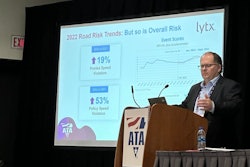On Sunday at the stroke of 2 a.m., the clocks rolled back one hour as Daylight Savings Time came to an end. This hour, hopefully you enjoyed it, because it's just about the only break the trucking world gets in a year.
November 7 was the start of Drowsy Driving Awareness Week, an effort by the National Sleep Foundation (NSF) and others to get the word out about just how important sleep to road safety. To those in the trucking world, of course, road safety is workplace safety.
The NSF estimates that more than 37 million passenger car drivers will drive drowsy at least once this year, that they'll kill an estimated 6,400 people this year and that across the board. Drivers seem to brush it off with more than six in 10 admitting to driving when they're fighting to keep their eyes open.
Professional drivers, of course, have a bit more structure and regulation around their driving habits than a passenger driver, but NSF Vice President Dr. Joe Dzierzewski said that truck drivers are actually at increased risk of being involved in a drowsy driving accident.
"Research shows upwards of 15% of all big rig crashes have fatigue or sleepiness as a cause, and there's a lot to be done in terms of driver awareness," said Dzierzewski.
The NSF has a handy guide on strategies to fight drowsy driving, most of which simply recommends healthy, consistent behaviors that Dzierzewski admits can be hard in the truck driving lifestyle.
Hours of service regulation "goes against the nature of our body clocks," he said. Furthermore, sometimes a load needs hauling at night. The International Agency for Research on Cancer makes no bones about it; night shift work is "probably carcinogenic," the organization said in 2019. Dzierzewski pointed to an "increased rate of stroke, heart attacks, depression, and anxiety" as well as more vehicle crashes for people who work nights.










